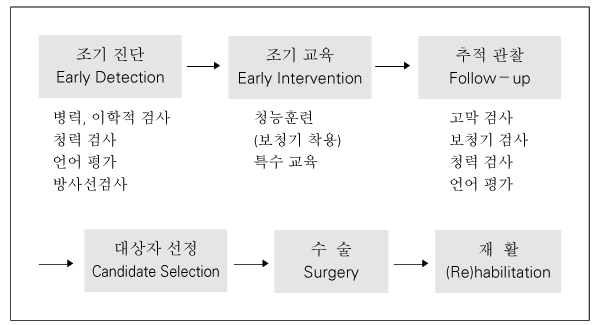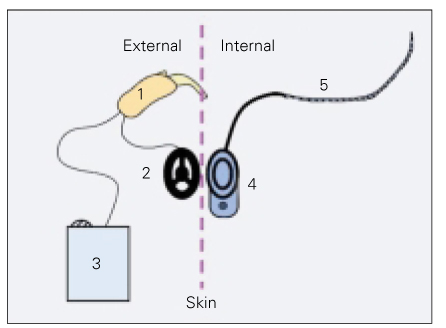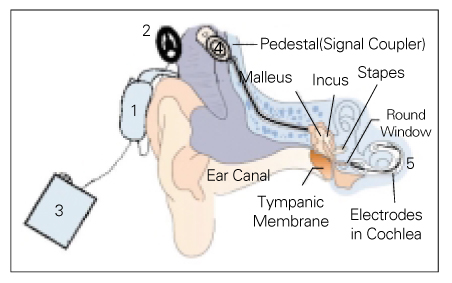J Korean Med Assoc.
2004 Dec;47(12):1205-1213. 10.5124/jkma.2004.47.12.1205.
Update on the Management for Sensorineural Hearing Loss in Children
- Affiliations
-
- 1Department of Otolaryngology and Head and Neck Surgery, Dong-A University College of Medicine & Hospital, Korea.
- KMID: 2065216
- DOI: http://doi.org/10.5124/jkma.2004.47.12.1205
Abstract
- Children with sensorineural hearing loss are managed with hearing aids or FM systems and also receive auditory and speech-language rehabilitation therapies when indicated. Children under auditory rehabilitation receive audiologic monitoring and language evaluations at 3-month intervals. Cochlear implants can be an option of choice for children aged 12 months or older with severe to profound hearing loss who show limited benefits from conventional amplifications. The cochlear implant is an electronic device that can provide auditory sensation to a person with severe to profound sensorineural hearing loss. The cochlear implant bypasses the damaged organ of hearing and stimulates the auditory nerve directly. The cochlear implant consists of a surgically implanted component and an externally worn component. Before receiving an implant, each child is carefully evaluated by the cochlear implant team to determine if an implant is right for him or her. The parents and the child are provided with counseling and guidance about the implant systems available and what they can expect. As the criteria for cochlear implants expanding in children, an increasing number of children with severe malformation of the inner ear or multihandicapped children are being considered for cochlear implantation. Three to four weeks after the surgery, the child is evaluated for fitting of the external device. After the device has been properly fitted, the child continues to follow his or her training program to learn to use the new sound provided by the implant. The use of cochlear implants in children with hearing impairment is a safe and effective way to improve speech and language when the benefits from hearing aids are limited.
MeSH Terms
Figure
Reference
-
2. Pediatric Working Group of the Conference on Amplification for Children With Auditory Deficits. Amplification for infants and children with hearing loss. Am J Audiol. 1996. 5:53–68.3. Djourno A, Eyries C, Vallancien B. De l'excitation electrique du nerf cochleaire chez l'homme, par induction a distance, a l'aide d'un micro-bobinage inclus a demeure. C R Soc Biol(Paris). 1957. 151:423–425.4. Clark GM, Pyman BC, Webb RL, Bailey QE, Shepherd RK. Surgery for an improved multiple-channel cochlear implant. Ann Otol Rhinol Laryngol. 1984. 93:204–207.
Article5. Arts HA, Garber A, Zwolan TA. Cochlear implants in young children. Otolaryngol Clin North Am. 2002. 35:925–943.
Article7. Kileny PR, Zwolan TA, Zimmerman-Phillips S, Telian SA. Electrically evoked auditory brain-stem response in pediatric patients with cochlear implants. Arch Otolaryngol Head Neck Surg. 1994. 120:1083–1090.
Article8. Cochlear Implants in adults and children. NIH Consensus statemen. 1995. 13:14–17.9. Cohen NL, Hoffman RA, Stroschein M. Medical or surgical complications related to the Nucleus multichannel cochlear implant. Ann Otol Rhinol Laryngol Suppl. 1988. 97:8–13.
Article10. Ling D. Foundations of spoken language for hearing-impaired children. 1989. Washington DC: Alexander Graham Bell Association for the Deaf.11. Bess FH. Children with hearing impairment : contemporary trends. 1998. Tennessee: Vanderbilt Bill Wilkerson Center Press.12. Estabrooks W. Auditory-Verbal therapy for parents and professionals. 1994. Washington DC: Alexander Graham Bell Association for the Deaf.13. Clark GM, Cowan RSC, Kowell RC. Cochlear implantation for infants and children : Advances. 1997. Sandiego London: Singular Publishing Group Inc..14. Advanced problem solving Workshop. 2002. Melbourne, Australia.15. Ching TY, Psarros C, Hill M, Dillon H, Incerti P. Should children who use cochlear implants wear hearing aids in the opposite ear? Ear Hear. 2001. 22:365–380.
Article16. Pollack D, goldberg D, Caleffe-Schenck N. Educational audiology for the limited-hearing infant and preschooler : An auditory-verbal program. 1996. Springfield, Illinois: Charles C Thomas Publisher.17. Bertram B, Lenarz T, Lesinski A. Waltzman SB, Cohen NL, editors. Cochlear implant for multihandicapped children : pedagogic demands and expectations. Cochlear Implants. 2000. New York: Thieme Medical Publisher;247–249.18. Pediatric cochlear implant training Workshop. 2004. Melbourne, Australia.20. Nikolopoulos TP, O'Donoghue GM, Archbold S. Age at implantation : its importance in pediatric cochlear implantation. Laryngoscope. 1999. 109:595–599.
Article21. Nikolopoulos TP, Archbold SM, O'Donoghue GM. The development of auditory perception in children following implantation. Int J Pediatr Otorhinolaryngol. 1999. 49:Suppl 1. S189–S191.22. Allen MC, Nikolopoulos TP, O'Donoghue GM. Speech intelligibility in children after cochlear implantation. Am J Otol. 1998. 19:742–742.
- Full Text Links
- Actions
-
Cited
- CITED
-
- Close
- Share
- Similar articles
-
- Rehabilitation of Sensorineural Hearing Loss: Hearing Aid
- The Characteristics and the Changes of Tinnitus according to the Recovery of Hearing Loss in the Patients with Sudden Hearing Loss
- Cochleovestibular Otosclerosis Without Conductive Hearing Loss
- Successful treatment of sensorineural hearing loss in Sjögren's syndrome with corticosteroid
- Fatal Case of Klebsiella Meningitis Combined with Bilateral Sudden Sensorineural Hearing Loss: A Case Report and Literature Review




